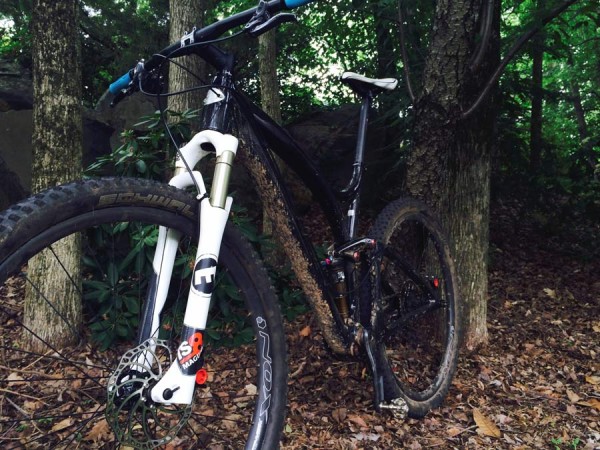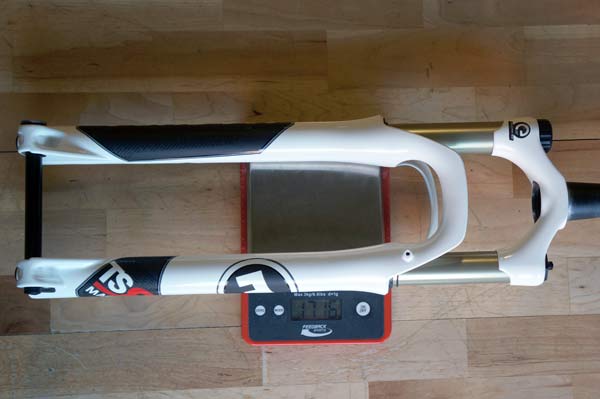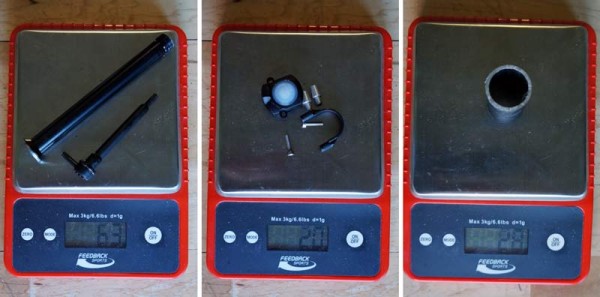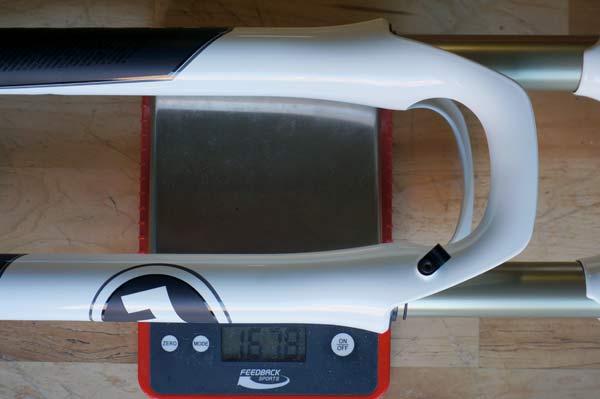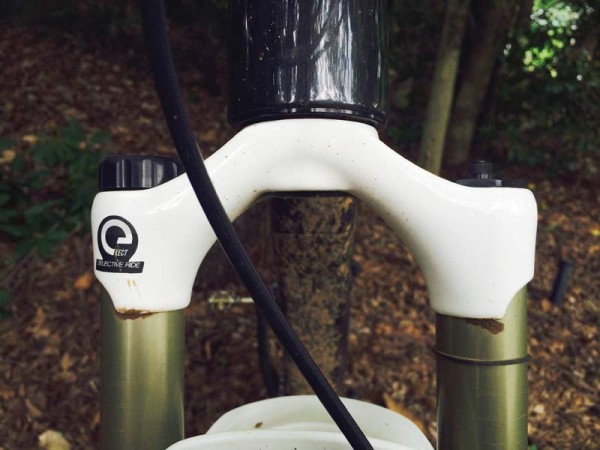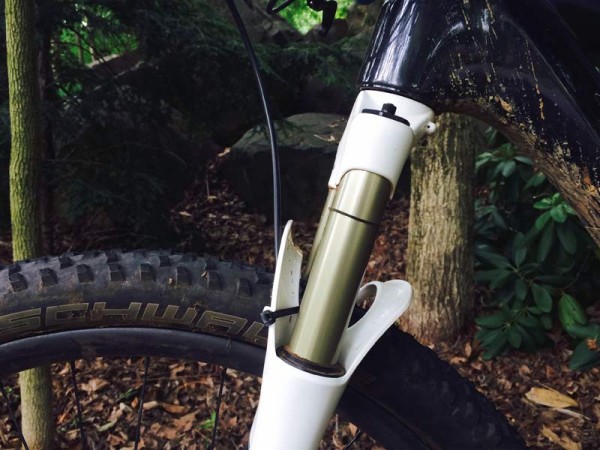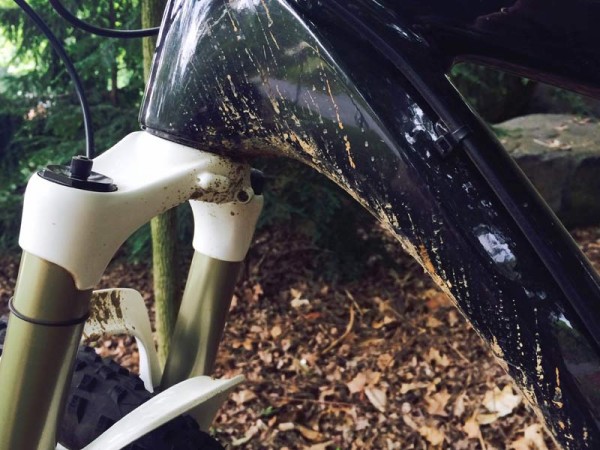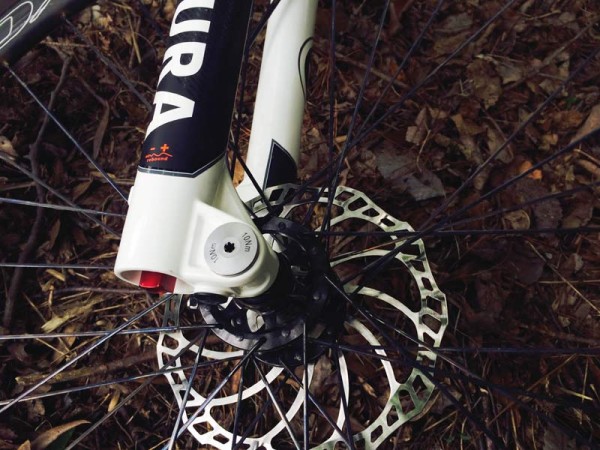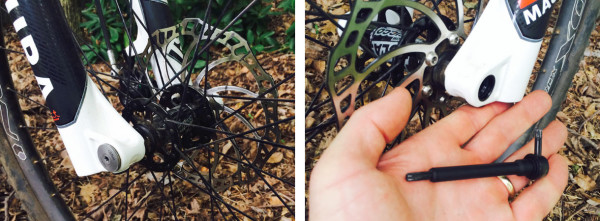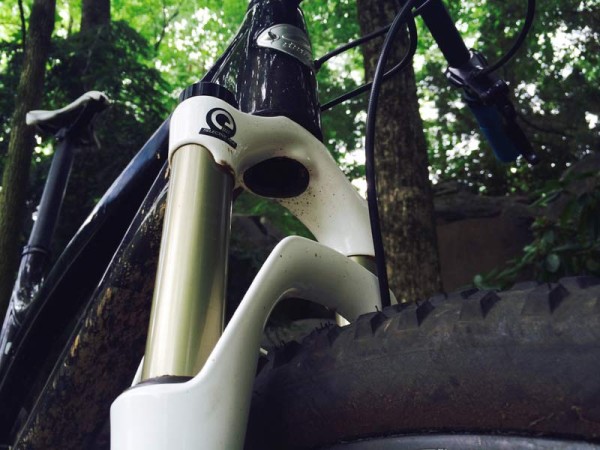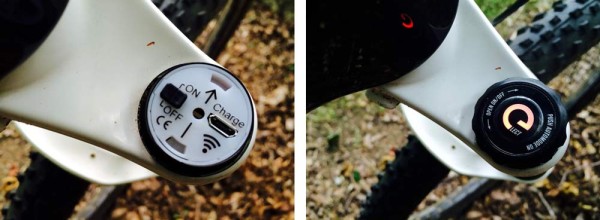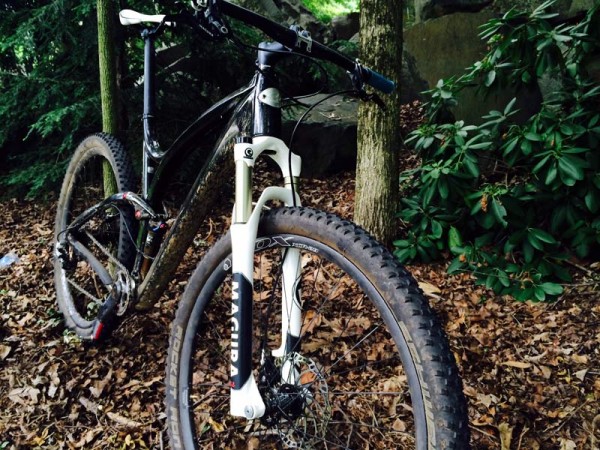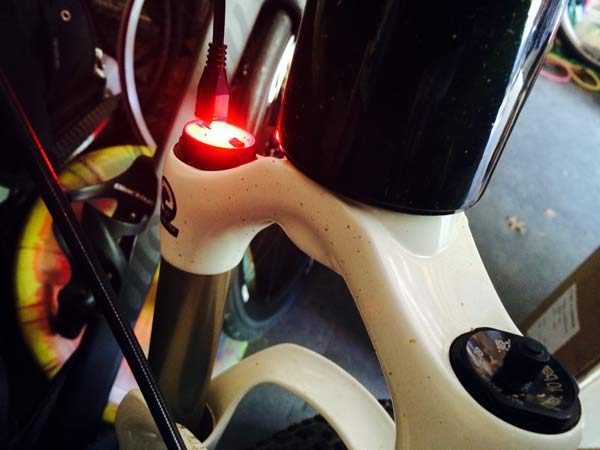Last summer, Magura introduced their eLECT suspension fork with built in sensors to automatically stiffen the fork up for climbing. It also gave the rider manual control over lock out by way of a Bluetooth remote button.
Where the Rockshox/Lapierre collabo utilizes outboard sensors and the Fox iCD is simply a manually controlled electronic lockout lever, Magura’s system is both simpler and smarter. It’s simpler in that it only has a lockout mode, not a multi-mode like the Rockshox system with variable levels. It’s smarter in that it does the lockout on its own, not requiring the flick of a switch. As such, it makes for a very efficient, lightweight system that (in it’s best configuration) requires absolutely no thought from the rider, leaving you to focus on racing. That’s good, because this fork and the eLECT system is itself entirely focused on racing as far as I’m concerned. For now anyway – there are a few changes and some interesting product testing going on at Magura, which I’ll recap at the end.
Check out the tech, weights and ride review to see how it all works…
ACTUAL WEIGHTS
I tested the 2014 TS8 29er fork set at 100mm travel. Uncut steerer with axle and tool but without brake hose guide: 1,716g
Thru axle and tool (63g), Bluetooth remote and mount w/ battery installed (20g) and cut portion of steerer tube (28g) to fit a size Large Niner Jet9 RDO with a couple short spacers.
Fork with cut steerer, axle/tool and brake hose retainer: 1,678g (3.7lb)
Among XC forks, that’s on the respectably low end of similar 29er forks we’ve weighed (Rockshox Reba, Manitou Tower, X-Fusion Trace).
DETAILS
Magura’s TS-series forks have a heavily shaped crown with full alloy tapered steerer. Tech specs include 32mm stanchions and 510mm axle to crown height.
A dual arch keeps the lowers stiffer, which allows for smoother action and less twisting.
The crown is shared with other models that get various mechanical remote functions, thus the cable guides on the back. Some Grindium could remedy those…
On the left is the air chamber’s valve, which handles both positive and negative. Magura’s “keep it simple” philosophy is alive and well here, with minimal external adjustments. Fortunately, they work quite well.
A red knob on the bottom controls rebound speed. Rubber bumpers protrude from the bottom, protecting the fork when the wheel’s out…and keeping it from sliding around, helping keep the bike upright while you fix a flat, etc.
Magura’s 15mm thru axle uses a T25 Torx tool to install, and the tool is conveniently tucked inside the axle on the non-drive side. Magura’s brakes mount with T25 bolts, too, making the tool very handy and quickly accessible. All of their 29er forks are designed for a minimum 180mm rotor.
Compared to the 2013 TS8 forks, the 2014 models received completely revamped seals, bushings and switched from oil to grease. These moves made the forks smoother and simpler to work on. They also added physical volume spacers rather than suggesting added oil to the air chamber to adjust the fork’s progressiveness.
The eLECT damper, which pulls out as a unit and is entirely replaceable or swappable for traditional units, has a physical on/off switch, charge port and indicator light under a plastic cover.
What is eLECT in terms of Magura’s lineup? DLO2 is essentially the analog version of eLECT with two positions, firm or open. DLO3 adds a third, intermediate position. The unadvertised benefit of DLO3 is that you can remove the top cap/switch and tweak the low speed compression (a bit) with an allen wrench. All three models have a spring loaded blowoff in the firm (aka lockout) mode, so if you hit something big, it’ll still move, albeit a bit more harshly than normal, but you won’t be knocked off the bike or damage the fork.
In practice, the closed mode is more of a very, very firm setting rather than true lockout.
The low speed compression damper is a shim stack that’s controlled by a small servo motor and, for the eLECT models, is either open or closed. The amount of compression is not user adjustable on eLECT models, and high speed compression is factory set on all of their forks.
Compared to a similar DL2 model with mechanical lockout, the eLECT version is a bit lighter since it doesn’t need the cable, housing and lever. Take away the remotes, and the eLECT is only a few grams heavier
HOW eLECT WORKS
The gist of it is simple: 3D accelerometers inside the fork measure incline angle, free fall and acceleration, then adjust the fork to the open or closed setting as necessary. While there aren’t buttons or dials to adjust it, you do have control over the angle at which it firms up.
The printed instructions are crap. They’re not written in a linear way that’s clear to the user, which means too much time spent reading and re-reading them to do something simple. All that’s required is to set the bike on level ground and hold the button for 3-5 seconds. Let go and it’ll blink twice to confirm calibration. This process is mandatory for eLECT to work properly because it tells the fork where its neutral setting is.
From there, a change of 6.5º in incline will close the valve and lockout the fork. If you want it to lockout on less of a pitch, then you simply raise the rear end of the bike slightly and recalibrate. If you want it to remain open on mild inclines, calibrate with the front end raised slightly. Once on the trail, it has a two second reaction time before firming up. That keeps it from opening and closing on every little roller or when you lift the front end to clear a log or something.
Because it measures free fall, it’ll open up in just 0.2 seconds if it senses the bike getting airborne so it doesn’t land too harshly. And, in a pretty trick feature they didn’t mention at launch, it even measures acceleration. Go for that finish line sprint and it’ll firm up for about two seconds to give you a little edge. Thanks to its three dimensional accelerometer, it knows the difference between a finish line sprint and hauling arse downhill.
It’ll get 40 to 60 hours of active battery life per charge. Not standby, but actual riding time. In automatic mode, battery life is on the shorter side of that since it’s having to process information constantly. They actually slowed down the processing a bit so that it wouldn’t over react to rollers and subtle changes, which also helped boost battery life, but it’s plenty quick enough to react to trail chatter and obstacles. Manual mode will help it last a bit longer, but you need to use the wireless (ANT) remote to manually lock it out. If you just want it open all the time, you could either use the remote, or just turn the fork off. The battery itself has about 1000 charge cycles, so there’s basically no way you’ll need to replace it. They do, however, offer a replacement and software upgrade service just in case.
When not moving, the system goes to sleep in two minutes. It wakes up after 8 seconds of movement, and Jude Monica, Magura’s NA Technical Service Manager, says you can basically just leave it switched on all the time. He says putting it on a vehicle rack won’t cause it to wake up because the movement’s too slow.
Bluetooth remote: The multi-button remote shown above is what comes with the new eLECT rear shock, which is only really available if you’re getting the fork, too. The center button locks both simultaneously. The rear-facing button locks just the shock, and the forward-pointing button the fork. Switch the remote to the other side of your handlebar and you can reprogram it to still work in the same manner, keeping the button placement logical.
If you’re just buying an eLECT fork aftermarket, you’ll get a single button Bluetooth controller like what’s shown on the scale, which cycles between automatic, locked and open modes. I didn’t use it, and I’m not alone in that…
RIDE REVIEW
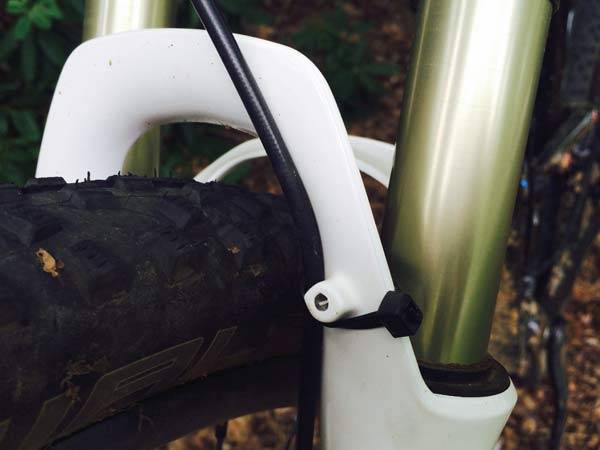
Magura’s suspension forks over the last couple years have been impressive. I’ve tested a 2013 TS8 DLO2 in 120mm travel and now this 2014 TS8 eLECT in 100mm travel. Both offer smooth action, stiff lowers and fairly plush performance. Compared to what else is out there, the actual suspension performance leaves nothing to be desired, and the simplicity of their controls is great for those that like to set it and forget it.
Tracking over rough terrain is solid, and the compression tune seems right for it’s intended purpose as an XC/Trail fork.
While it’s a bit hard to compare different travel forks as apples to apples, I can say the updated internals are very good, and the new air volume spacers make for easier tuning. Forks are shipped without any spacers installed, but two different sizes are offered in the U.S., three in Europe and elsewhere. These are a welcome addition to the aftermarket lineup. While the 100mm travel eLECT tested here didn’t suffer from it, the TS8 120mm fork on hand tended to dive into it’s travel too easily under braking or standing pedaling. The solution, before the spacers, was to add Magura’s fork oil to the air chamber to take up space. The new spacers are a cleaner, more precise method of tuning that any one can do by simply removing the top cap (after letting the air out!!!) and snapping them into place.
As for the electronics, they work amazingly well. In reality, it’s a feature only racers are likely to want. It’s currently only for 80-120mm forks, for one, and without such a feature, I virtually never lock my fork out. I have a suspension fork because I want it to soak up bumps. But having the fork switch modes for me proved rather nice. It’s noticeable when standing to crank up a hill or using a little rocking body motion to grind up a steep section. And standing to sprint is impressively effective – no more fork bob! I have to admit, it’s pretty cool and useful. For those looking to maximize efficiency without having to fiddle with levers or buttons in the heat of battle, the eLECT TS8 combines light weight, great suspension performance and this killer automatic lockout into a package that’s only a bit more expensive than other top end XC forks.
About the remote: I didn’t use it. After all, with the eLECT system carrying a $500 premium over the DLO2/DLO3 forks, why would I want to turn the automatic function off? Jude says riders he’s talked to play with the remote for the first 15 minutes, then don’t touch it. And he says some OEM customers don’t even spec the remote, mounting eLECT forks and shocks that without the ANT+ transmitter/receiver built in, so they wouldn’t work with the remote anyway.
FUTURE ITERATIONS & UPDATES
The current version of eLECT is meant for forks with 120mm of travel and less. Magura Product Manager Stefan Pahl says “the compression setup is made with a harder setting, suitable for XC/marathon use. On longer travel forks it will be too harsh.”
Buuuut, a longer travel version that simply mutes the damping a bit without going completely firm could be just the ticket for enduro. Imagine hitting that flat or slightly inclined stretch during a timed segment and being able to hammer efficiently through it, then having the fork immediately open back up for the remainder of the descent. Magura’s thinking the same thing, according to Pahl: ” New eLECT units, available from this autumn onwards will have a softer compression setting and a harder blow off. These can well be used also on longer travel forks.”
They also offer an eLECT upgrade kit that’ll drop in the new compression management rod that drops into the top of the fork on any Magura fork from 2010 to present. Yours for only $600.
The original eLECT forks used standard ANT. The new eLECT rear shock is ANT+, so if you were to add the shock down the road, the remote would not work with it. Current production models are ANT+ for both front and rear, and if you did want to upgrade your whole bike, the brains of the fork can be reflashed to work with ANT+. The new remotes use three buttons, one for front, one for rear and one for both. And you can program the buttons to work with front or rear, letting you position it on either side of your handlebar and have the rear button work the rear shock, keeping it intuitive.
